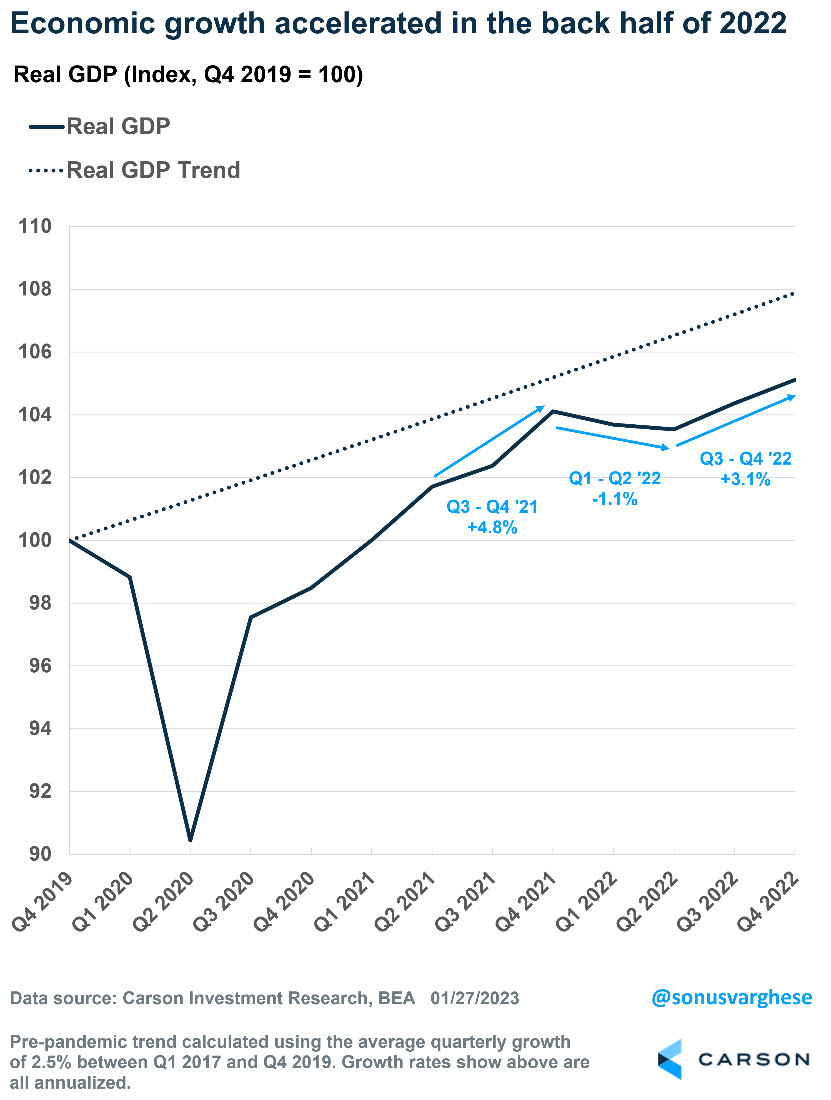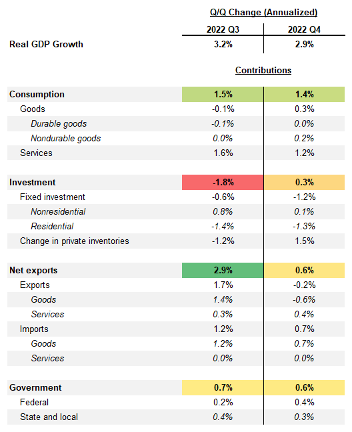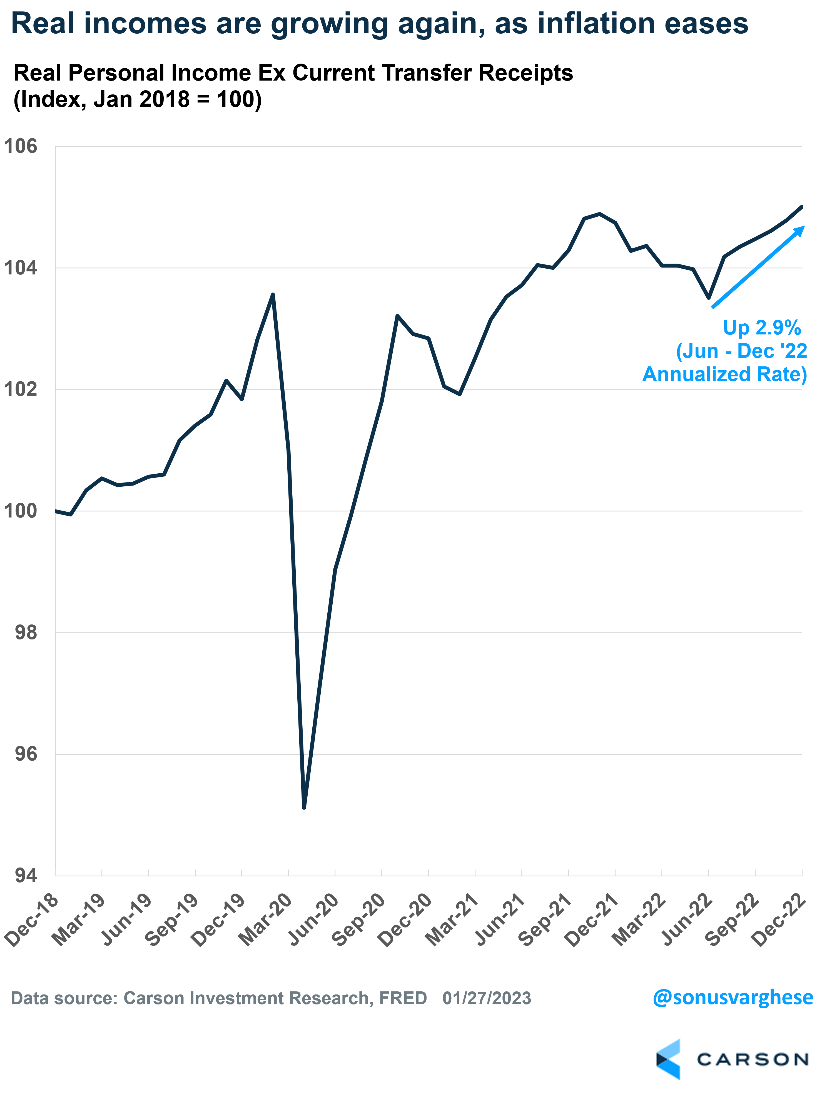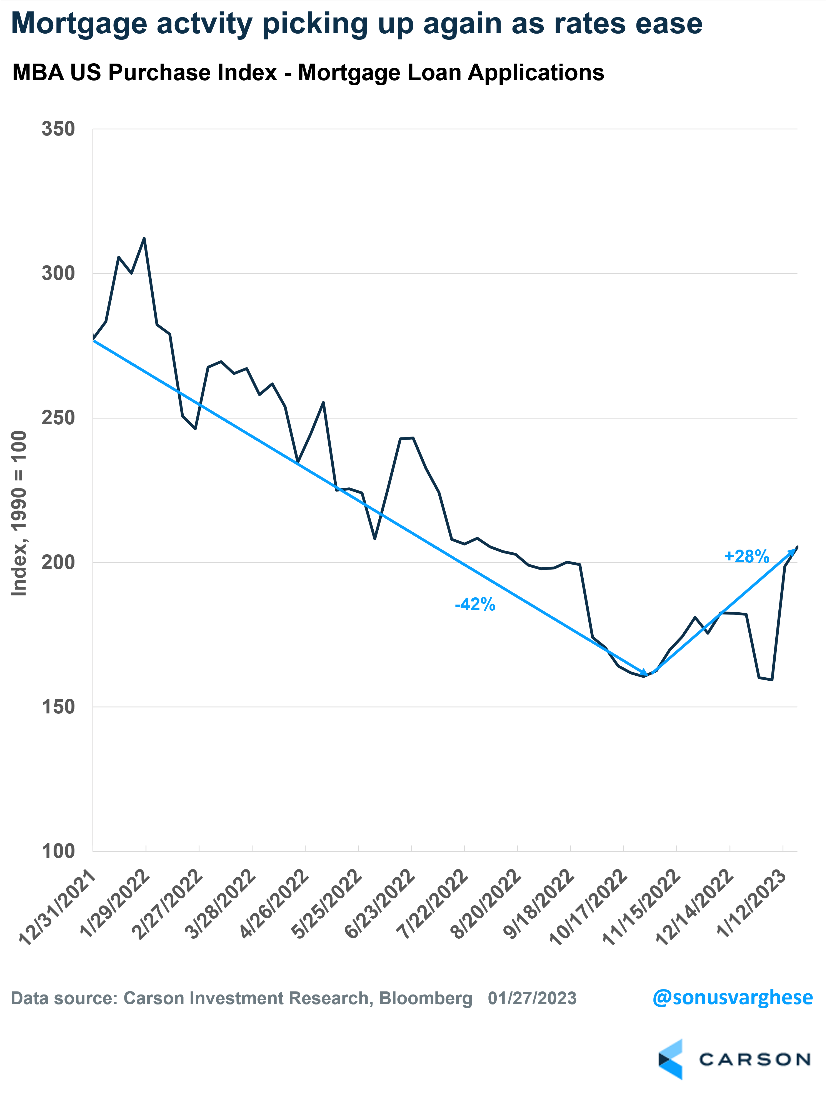Last week the stock market rally continued, with various sectors showing renewed strength. This time a year ago, defensive areas, such as utilities, consumer staples, and health care, were leading. That was a warning sign, and it sure turned out something was wrong. Today small-caps, cyclicals, industrials, and technology are leading. These are more risk-on areas and their strong performance is another sign of underlying health.
- The stock market’s great start to the year continued last week, which could be a good sign as strong starts can open the door to more gains.
- Better overall economic data last week continued to increase the chances of avoiding a recession in 2023.
- The consumer remains in solid shape and will help offset weakness in the housing sector.
- Price pressures continue to ease, and the inflation outlook remains good.
With only two days to go, the stock market is off to one of its best January starts, with the S&P 500 up close to 6%. This is a great sign for the bulls, as the so-called January Barometer is typically a good indicator for the year. When stocks are green in January, the next 11 months are up close to 12% on average, and the market is higher 86% of the time. When January is down, such as it was in 2022, those averages drop to 2.1% and 60%, respectively.
When January is up more than 5%, the returns get even better. The following 11 months are up more than 14% on average, and the market is higher nearly 86% of the time.
We wouldn’t suggest blindly investing based on January’s performance, but the returns provide another clue that conditions have changed and higher stock prices in 2023 could be quite likely.
More Strong Economic Data
The latest GDP growth numbers for the fourth quarter of 2022 came in at 2.9% quarter-over-quarter (annualized rate), which was higher than expectations for a 2.6% reading. This is only slightly below the third quarter growth rate of 3.2%. The first two quarters of last year saw negative growth, so this is a nice bounce back.
Over the full year, GDP growth was up just 1% compared to the end of 2021. But this hides the fact that economic growth picked up in the second half of 2022. However, the first-half slowdown leaves the economy about 2.5% below its pre-pandemic trend.
The big picture: The economy is more than 5% higher than it was at the end of 2019, which shows how strong the recovery has been despite the early slowdown in 2022. The employment data corroborate this as well.
Details Matter
GDP is measured as:
GDP = Consumption (68%) + Investment (18%) + Government Spending (17%) + Net Exports (-3%)
Note that net exports are exports minus imports, and since the U.S. imports more than it exports, net exports tend to be a drag.
The table below shows how the various components contributed to GDP growth in the third and fourth quarters. Consumption contributed close to the same amount in both quarters. But in the third quarter the other big driver of GDP growth was net exports, whereas in the fourth quarter it was “change in private inventories.” These are the two most volatile elements of GDP, which is why it helps to look under the hood.
The details also help us to consider how the markets and economy will behave in 2023. For that let’s start with the most important category — consumption, which makes up just under 70% of the economy.
Consumption Stays Solid, Even as Services Normalize
Consumption barely slowed from the third quarter, but there were important differences. Services consumption eased, rising 2.6% in the fourth quarter compared to 3.7% in the third. But that 2.6% pace is well above the 2015-2019 average of 1.9%.
The good news is goods spending picked up in the fourth quarter and offset some of the services slowdown. This was almost entirely due to increased auto sales, gas, and grocery purchases — the latter two thanks to lower prices. This is important because we believe this trend will continue into early 2023, especially with auto sales and production picking up. Further good news: Consumers have more money in their pockets due to falling inflation, which will be a tailwind for consumption.
Housing Slowed, Thanks to the Fed
The Fed’s aggressive rate hikes had barely any impact on consumption last year. They did have an impact on investment, specifically residential investment, i.e., housing. Higher interest rates led to higher mortgage rates, and that led to a crash in housing activity. Housing pulled economic growth down by about 1.3-1.4 percentage points in the third and fourth quarters. Across 2022, residential investment fell 11%, which is the largest drop since 2009 when it fell 22%.
The good news is housing data appear less bad. In fact, mortgage activity has even picked up recently with rates pulling back from peak levels. So, there is sound reason to think housing will be less of a drag in 2023.
Nonresidential investment also slowed, which is concerning because it indicates businesses are investing less. However, it turns out the pullback in the fourth quarter was due to businesses spending less on communications equipment, which may simply be a reversal of spending that occurred after the pandemic hit when employees had to shift to their homes.
Government Spending No Longer a Drag
Investors forget that government spending makes up about 17% of the economy, and it matters. Over the last two quarters, government spending has picked up, reversing the drag from the prior five quarters. This has helped offset some of the pullback in private investment. It also is in sharp contrast to what happened after the 2008-2009 recession, when government spending was slashed and remained a drag on GDP growth all the way through 2014.
Government spending should continue to add to GDP growth in 2023. Congress passed some big spending bills over the past year and half: a $1 trillion infrastructure bill, the Inflation Reduction Act, and a $1.7 trillion government budget, which increased spending significantly. The money will really start to flow into the economy in 2023.
Still No Sign of a Recession
As we wrote in our recently released 2023 outlook, we don’t expect a recession in 2023, and the latest data corroborate that story.
Our reasoning is simple: Inflation is slowing, and if employment and incomes hold up (as they seem to be doing), real incomes will rise. Considering goods consumption is likely to recover on the back of vehicle purchases, we’re expecting consumption to remain solid.
Beyond that, housing should be less of a drag in 2023, especially as the Fed eases rate hikes, which looks likely to happen. So, the peak negative impact of aggressive rate hikes may be behind us.
Non-residential investment, especially in structures and equipment, may remain weak. However, recovering auto production, and even aircraft orders, should help U.S. manufacturing. That will be enhanced as the global economy starts to strengthen later in 2023, which should also help exports.
GDP growth data may be volatile due to unpredictable inventories and net exports, as we saw in 2022. But the underlying message is there still is no sign of a recession.
This newsletter was written and produced by CWM, LLC. Content in this material is for general information only and not intended to provide specific advice or recommendations for any individual. All performance referenced is historical and is no guarantee of future results. All indices are unmanaged and may not be invested into directly. The views stated in this letter are not necessarily the opinion of any other named entity and should not be construed directly or indirectly as an offer to buy or sell any securities mentioned herein. Due to volatility within the markets mentioned, opinions are subject to change without notice. Information is based on sources believed to be reliable; however, their accuracy or completeness cannot be guaranteed. Past performance does not guarantee future results.
S&P 500 – A capitalization-weighted index of 500 stocks designed to measure performance of the broad domestic economy through changes in the aggregate market value of 500 stocks representing all major industries.
The NASDAQ 100 Index is a stock index of the 100 largest companies by market capitalization traded on NASDAQ Stock Market. The NASDAQ 100 Index includes publicly-traded companies from most sectors in the global economy, the major exception being financial services.
A diversified portfolio does not assure a profit or protect against loss in a declining market.
Compliance Case # 01640562







